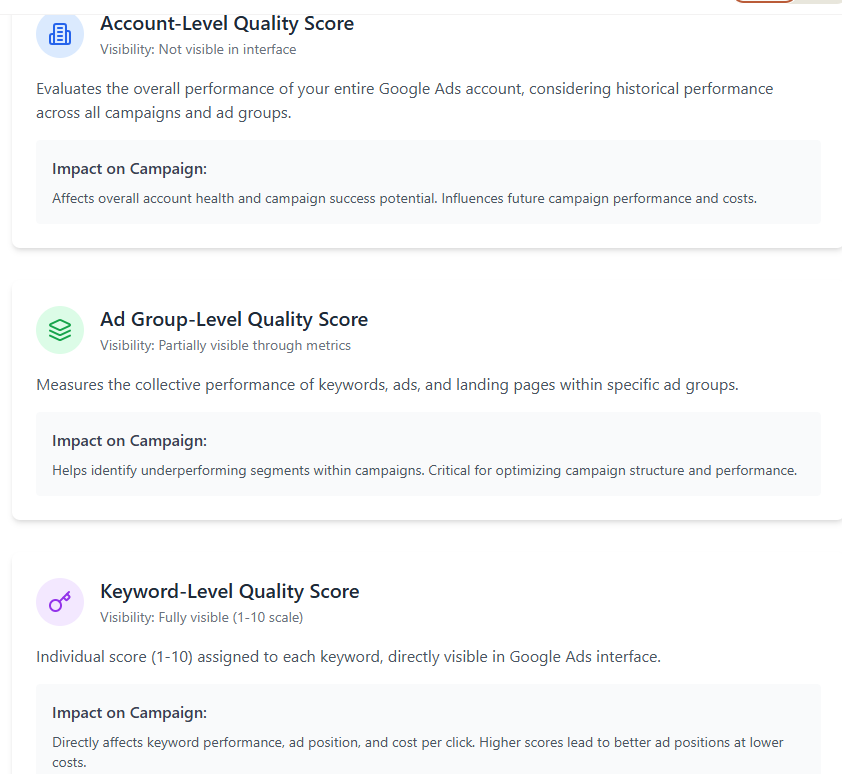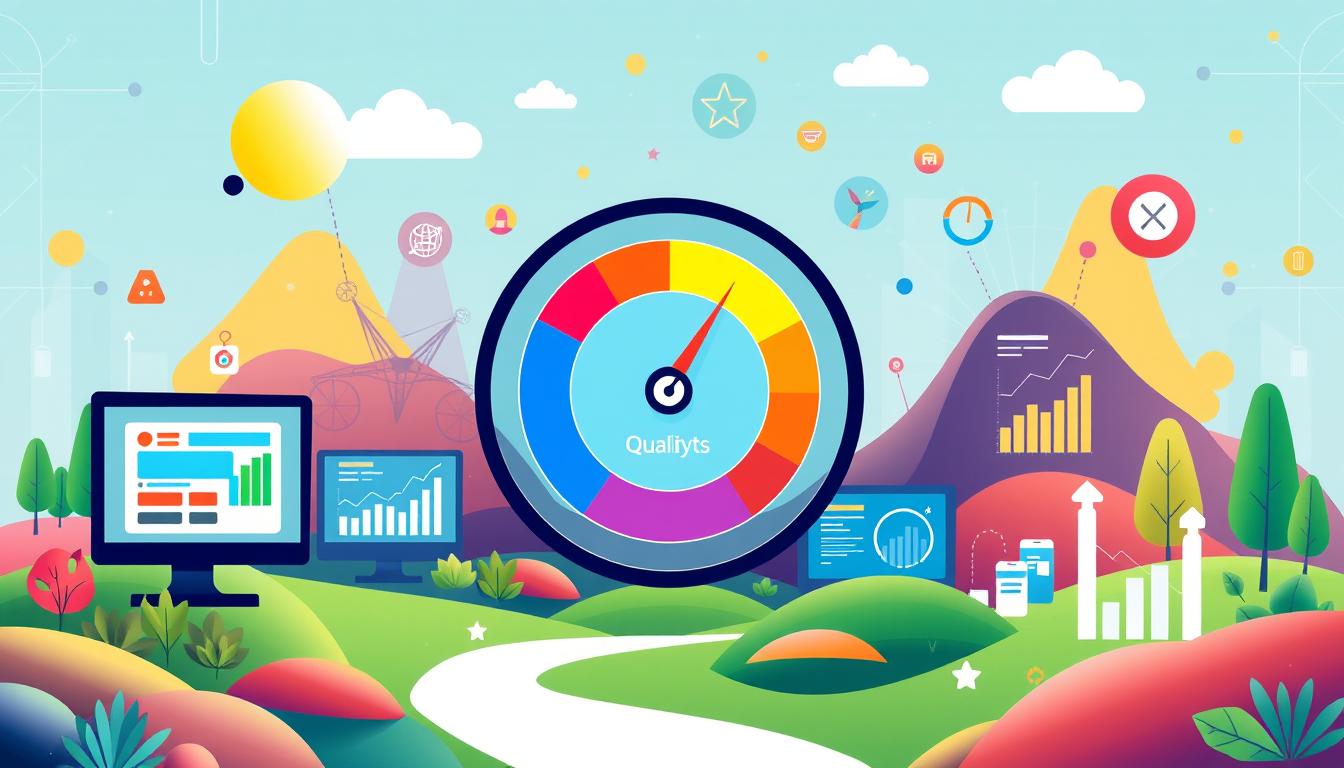Google Ads Quality Scores: What You Need to Know
Did you know a Google Ads Quality Score of 10 can cut your Cost Per Click (CPC) by 50%? This shows how important quality scores are for ad performance and cost. We’re exploring the world of Google Ads quality scores to understand their role in your ads.
Google’s Quality Score ranges from 1 to 10. A score of 1 can make you pay up to 400% more for clicks. But a perfect 10 can cut costs in half. This makes it key to know and improve your Quality Score for better returns.
Quality scores do more than save money. They also affect your ad rank, which decides your ad’s visibility. With Ad Rank being Max CPC times Quality Score, a better score means more visibility without spending more.
We’ll look into Quality Score’s parts like Expected Clickthrough Rate (CTR), Ad Relevance, and Landing Page Experience. We’ll also share tips to improve them. Knowing these is vital for making effective, affordable Google Ads campaigns.
Key Takeaways
- Quality Scores range from 1-10, with higher scores leading to CPC discounts
- A Quality Score of 10 can result in a 50% CPC reduction
- CTR weight accounts for 90% of the Quality Score calculation
- Ad Rank is determined by multiplying Max CPC and Quality Score
- Improving landing page experience can positively impact Quality Score
- Quality Score affects both CPC and Return on Advertising Spend (ROAS)
- Google recalculates Quality Score each time an ad is shown
Understanding Quality Score Fundamentals
Google Ads Quality Score is key for advertisers. It rates your ads, keywords, and landing pages. We’ll explore what it means and how to boost your campaigns.
What is Google Ads Quality Score?
Google Ads Quality Score rates your ad from 1 to 10. It looks at your ad’s relevance, expected clicks, and landing page quality. This score affects your ad’s spot and cost.
The 1-10 Scoring System Explained
The Quality Score ranges from 1 (lowest) to 10 (highest). A score of 5 is average. Scores above 7 are good.
Your score affects your Ad Rank. It’s calculated by multiplying your CPC by your Quality Score.
Why Quality Score Matters for Advertisers
Quality Score is important for ad visibility, position, and cost. Higher scores mean better ad spots and lower costs. This boosts your campaign’s ROI.
Improving your Quality Score makes your ads more effective. It helps you reach your audience better.
“Advertisers with higher Quality Scores usually pay less per click compared to those with lower scores.”
Core Components of Quality Score
Let’s explore the key parts of quality score in Google Ads. Knowing these is key for a good score.
Expected Clickthrough Rate (CTR)
Expected CTR shows how likely people are to click your ad. It looks at past results and how well your ad matches keywords. A high CTR means your ad is engaging, which helps your score.
Ad Relevance Metrics
Ad relevance checks if your ad matches your keywords well. Writing ads that grab attention and use keywords helps here. Remember, being relevant is important for your score.
Landing Page Experience Factors
Your landing page is very important for your score. It should be easy to use, load quickly, and have the right content. A good landing page can really help your score.
| Component | Weight | Impact |
|---|---|---|
| Expected CTR | 39% | High |
| Landing Page Experience | 39% | High |
| Ad Relevance | 22% | Medium |
By working on these main parts, you can make your Google Ads better. A high score means lower costs and better ad spots.
Quality Score Google Ads: Impact on Ad Performance
The importance of quality score in Google Ads can’t be overstated. A high score boosts your ad rank. This affects where your ad shows up and how much you pay for clicks. Let’s look at the numbers to understand the impact.
Quality scores range from 1 to 10, with 10 being the best. Boosting your score from 5 to 10 can halve your ad costs. But, a score of 1 could make you pay 400% more than average. This highlights how key quality score is for your budget and campaign success.
| Quality Score | Cost Reduction |
|---|---|
| 6 | 16.7% less |
| 7 | 28.6% less |
| 8 | 37.5% less |
| 9 | 44.2% less |
| 10 | 50% less |
Quality score does more than just save money. Higher scores mean better ad positions and more visibility. This leads to higher click-through rates. It’s good for your budget and marketing goals.
Different Types of Quality Scores
Google Ads quality scores are key to how well ads do and how much they cost. We’ll look at three main types: account-level, ad group-level, and keyword-level scores.
Account-Level Quality Score
The account-level quality score shows how well your whole Google Ads account is doing. It looks at how all campaigns and ad groups have performed over time. You can’t see this score, but it affects your account’s health and chances of success.
Ad Group-Level Quality Score
Ad group-level scores help find what needs work in certain campaigns. They look at how keywords, ads, and landing pages do together in a group. By working on low-scoring groups, you can make your whole campaign better.
Keyword-Level Quality Score
Keyword-level scores are the most important and easy to see. They affect how well each keyword does and are shown in the Google Ads interface. Scores range from 1 to 10, with higher scores meaning better performance.

| Keyword Type | Good Quality Score Range |
|---|---|
| Branded | 8-10 |
| High-Intent Commercial | 7-9 |
| Low-Intent | 7 |
| Competitor | 3+ |
Knowing about these Google Ads quality score types helps improve campaigns. By working on scores at all levels, you can make your ads better and save money.
How Quality Score Affects Ad Costs
Quality score is very important for Google Ads costs. A higher score can lower your cost-per-click (CPC). This makes your campaign more profitable.
The Google Ads Quality Score goes from 1 to 10. Scores of 7-10 mean your ads are good and cost less. But scores of 1-3 mean your ads are not as good and cost more.
| Quality Score | CPC Impact | Ad Position |
|---|---|---|
| 7-10 | Lower CPC | Better |
| 4-6 | Average CPC | Average |
| 1-3 | Higher CPC | Worse |
A high quality score means your ads cost less. This is because your ad rank gets better without spending more. You get better ad spots at lower costs, which helps your visibility and click-through rates.
To make your ads better, work on your click-through rate, ad relevance, and landing page. This way, you’ll spend less and get better results from your campaign.
Monitoring and Measuring Quality Score
It’s key to keep an eye on your Google Ads quality score for success. We’ll explore how to track and understand quality score reports.
Accessing Quality Score Data
To see your scores, add the Quality Score column in Google Ads. This shows how well your keywords are doing, from 1 to 10.
Understanding Quality Score Reports
Reports show your score in three parts: Expected CTR, Ad Relevance, and Landing Page Experience. Each is rated as “Below Average,” “Average,” or “Above Average.” This helps you know where to get better.
Historical Performance Tracking
Watching how your Quality Score changes is important. It shows trends and ways to improve your Google Ads. Regular checks help you fix issues fast and adjust your campaigns.
| Quality Score Component | Impact on Overall Score | Improvement Strategy |
|---|---|---|
| Expected CTR | High | Refine ad copy, use compelling calls-to-action |
| Ad Relevance | Medium | Align keywords with ad text, use targeted ad groups |
| Landing Page Experience | High | Improve page load speed, enhance content relevance |
By focusing on these areas and checking your reports often, you can boost your ad performance. This can also lower your costs in Google Ads.
Common Quality Score Misconceptions
We’ve seen many myths about Google Ads Quality Score. Let’s clear up some common misconceptions. This will help you manage your ads better.
One big myth is that Quality Score alone decides ad success. It’s not true. Quality Score is just one part. It works with bid amount and ad relevance to affect success.
Another myth is that Quality Score changes rarely. But, Google updates it with each search. This makes it a live metric showing real-time performance.
Many think Quality Score is the same everywhere. But, it’s not. While other platforms have similar ideas, their specifics and effects are different.
“Quality Score is a guide, not a goal. Focus on improving your ads’ relevance and performance, and a good score will follow.”
Knowing these facts is key to good Google Ads management. By clearing up these myths, you can focus on what really counts. Make ads that speak to your audience.
How To Improve Quality Score Using Powerful Methods
Boosting your Google Ads Quality Score is key for better ads and lower costs. Let’s explore some top strategies to improve your score and boost campaign success.
Keyword Optimization Techniques
To optimize keywords, aim for relevance and specificity. Use long-tail keywords that match user intent well. Also, add negative keywords to block unwanted traffic. Prioritize bottom-of-funnel keywords in your campaigns.
Ad Copy Enhancement Methods
Create ad copy that matches your keywords and what users expect. Use dynamic keyword insertion and location operators to increase relevance. Consider Single Intent Ad Groups (SIAGs) to target specific audience intents.
Landing Page Optimization Tips
Your landing page’s quality counts for 39% of your Quality Score. Make sure your pages are relevant, clear, and easy to use. Focus on mobile readiness and fast loading. Avoid misleading content to prevent high bounce rates and score drops.
By using these strategies, you can greatly improve your Google Ads quality score. Always keep improving and trying new things to stay ahead in Google Ads.

| Quality Score Component | Contribution to Overall Score | Optimization Focus |
|---|---|---|
| Expected CTR | 39% | Keyword relevance, ad copy quality |
| Ad Relevance | 22% | Keyword-ad match, SIAG implementation |
| Landing Page Experience | 39% | Relevance, usability, load speed |
Quality Score Impact on Ad Extensions
Quality score is very important for ad extensions in Google Ads. A higher score means your ads can be seen more and work better. This is true for extensions like sitelinks and callouts.
Sitelink Requirements
Sitelinks add extra links to your ads to get more clicks. But, you need a good quality score to use them. If your score is low, your sitelinks might not show up. This means fewer people will click on your ad.
Callout Eligibility
Callouts are short texts that show off your business’s best features. Like sitelinks, they need a certain quality score to appear. A better score means your callouts are more likely to grab attention.
| Extension Type | Quality Score Impact | Benefits |
|---|---|---|
| Sitelinks | High impact | More clicks, better visibility |
| Callouts | Medium impact | Highlight features, increase relevance |
Improving your quality score helps your ad extensions work better. This leads to better ad performance and more engaged users. Remember, every part of your ad campaign affects your quality score, so keep optimizing!

Conclusion
Quality Score is key in Google Ads. It affects ad costs and how visible your ads are. We’ve looked at why Quality Score matters and how to make it better.
Quality Score goes from 1 to 10. A higher score means your ads show up better and cost less to click on.
To get a better Quality Score, work on click-through rates and ad relevance. Make your ads catchy and use clear calls to action. Test different versions of your ads to see what works best.
Good keyword research and ad groups help a lot. This makes your ads more relevant to what people are searching for.
Using Google Ads quality score tips can lower costs and increase what you get back from ads. Watch your conversion rates, impression share, and bounce rates to see how you’re doing. A higher Quality Score means your ads work better and cost less.


